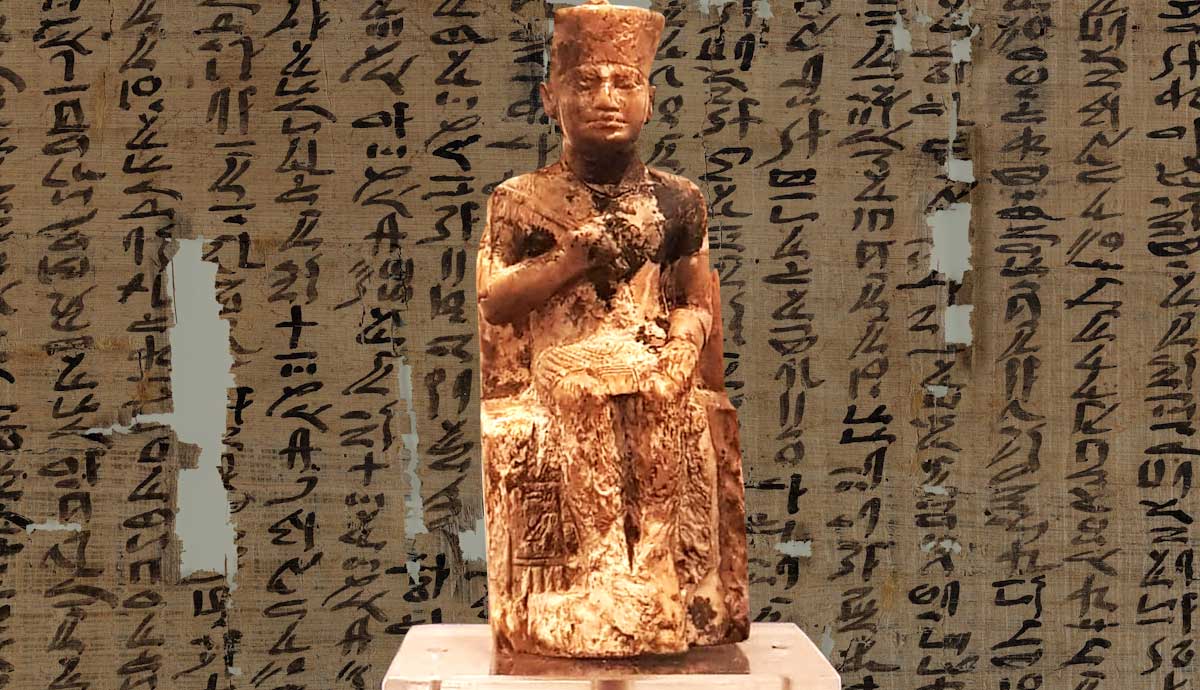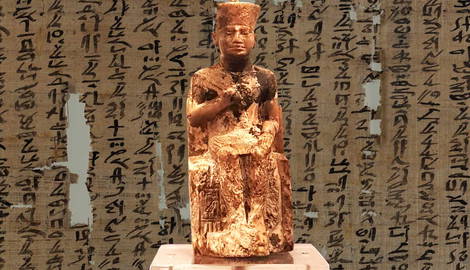
In 1825, British adventurer Henry Westcar bought a roll of papyrus as a souvenir from his trip to Egypt. Intrigued by the hieroglyphic text, and wanting to know what wonders it contained, Westcar entrusted its translation to German Egyptologist Richard Lepsius, who immediately knew he was before no ordinary Egyptian text. Papyrus Westcar told a series of fictional, albeit educational, stories that happened around the time of King Kheops (Khufu), roughly a thousand years prior to its creation. All the stories contained in the papyrus roll, including that of Khufu and the Magician, feature the use of magic, the telling of prophecies, and the performance of miracles, making it a fascinating document on Egyptian beliefs and magical knowledge.
Khufu’s Reign and the Westcar Papyrus

Khufu was the second pharaoh of the Fourth Dynasty of Egyptian kings. His greatest achievement, the Great Pyramid of Giza, is still standing today as a testament to the engineering skills and manpower the ancient pharaohs of Egypt could muster. He reigned in the middle of what is now known as the Golden Age of Pyramids, that is, the core part of the Egyptian Old Kingdom. This was the time when some of the most impressive monuments of ancient Egypt were built, and is generally regarded as a period of splendor for the Egyptian civilization.

There are three Khufus that we know of. The first is the real one, the actual man/god who ruled Egypt. We do not know too much about his character other than he commissioned the Great Pyramid, and he ruled right after Sneferu. Then, there is a second Khufu, which is described in the not-so-factual accounts of Manetho and Herodotus. In their work, and especially in the latter’s, Khufu is painted in a negative light as a cold-blooded tyrant who did not hesitate to force her own daughter into prostitution just to secure the funds for the Pyramid. There are reasons to doubt this description. Finally, the third and last Khufu is the one portrayed in the Westcar Papyrus. This was a character in a work of fiction, more than an account of a real person. And this is why, out of all the three portraits of Khufu, the real king remains a mystery.
Who Was Henry Westcar?

Egyptomania was at its peak during the Victorian Era of Britain. Wealthy socialites would constantly travel to Egypt in search of hidden treasure and mysteries. Although they mostly lacked formal training in archaeology or Egyptology, they sometimes made important discoveries that changed the way we think of ancient Egypt even today.
Sir William Wilde, Oscar’s father, was one of such explorers and uncovered thousands of animal mummies. But even before Queen Victoria ascended the throne in 1837, there were a few English gentlemen interested in traveling to faraway, exotic lands beyond. In particular, a hobby of the London elite seemed to be the collection of obscure Egyptian papyri. Although nobody knew what they said (the first successful efforts to decipher the Egyptian writing would be made by Jean-François Champollion in 1822), they made for exquisite and exotic curiosities in the cabinets of doctors and noblemen.
The family of Henry Westcar were friends with Dr. John Lee, lawyer and antiquary, who had in his possession an interesting judicial papyrus, but he did not know the contents. Henry took it upon himself to travel to Egypt and try to acquire a similar object, and it was not hard for him to do it since what we now know as the Westcar Papyrus was offered to him by a street vendor in a place never disclosed by the buyer. We do know the date on which it was purchased: 1825. After the decipherment of hieroglyphs, and eager to finally know what hidden knowledge his papyrus contained, Westcar gave the 2-yards long roll to the German Egyptologist Richard Lepsius, who put great effort in its translation. After Lepsius’ death, the papyrus was donated to the Egyptian Museum in Berlin, where it remains until this day.
History and Narrative in Ancient Egypt

Papyrus Westcar, as it turned out, contained several loosely connected stories, starring king Khufu. However, its date of creation was long after Khufu’s death, in the Second Intermediate Period (ca. 1782-1570 BCE), so very interestingly, it is a work of fiction that was set in the distant past, almost a thousand years prior to its writing. It may well be the first known historical fiction, as well as the first known magic text.
Egyptians were quite aware of their rich history. They kept track of their kings, for example, in the Abydos list. The earliest known list of Egyptian kings is contained in the so-called Palermo Stone, an artifact that details not only the kings and the years of their rule, but also important facts that happened each year, as well as the yearly height of the river Nile’s flood.
But it was not until the Middle Kingdom that a true ‘literature’ was born in ancient Egypt. A series of genres developed, including prophetic texts, laments, discourses, apocalyptic texts, negative confessions, and of course narratives about historical events and characters. This is the case of the text that is written on the Westcar Papyrus, an artifact from the 13th dynasty, which tells stories that supposedly happened during the 4th dynasty, a millennium or so before that time. The main characters were kings Khufu, Sahure, and Neferirkare, and the royal architect Imhotep.
The First Story – The Magic of Imhotep

Although in the few remaining parts that can be read (the papyrus is heavily damaged at the beginning and the end), his name is not mentioned, Imhotep is with all probability the main character in the first story. The story is told from the perspective of one of Khufu’s sons, probably Djedefre, and seems to tell the tale of how the royal architect Imhotep performed some kind of miracle for the king. The text then proceeds to describe in all detail the quantity and type of offerings king Khufu made for another king, Djoser, and for Imhotep. It is stated that Khufu was highly impressed with the mastery of Egyptian magic or Heka displayed by Imhotep, but unfortunately, we do not know anything about this miracle.
The Second Story – The Wax Crocodile

The second story, also incomplete, is told from the perspective of another pyramid builder, Khafre. But although he tells the story, it is a tale set during the reign of Nebka, implying that kings were well-versed in royal history. One of the chief royal priests learned that one of Nebka’s wives was having an affair with an unknown stranger from Memphis. And not only this, but it was right in front of his nose, as apparently, the stranger liked to bathe at the palace’s pool. The priest created a crocodile out of wax and electrum, and instructed an aide to throw the crocodile doll in the water as soon as he saw the stranger get in it. The aide did so, and upon contact with the water, the crocodile came to life and trapped the man, keeping him at the bottom of the pool for seven days.
After seven days had passed, the priest informed his majesty of the occurrence. Immediately, Nebka asked for the man to be brought into the palace and before him. The priest then asked the crocodile to bring the man, and upon setting foot on land, the crocodile returned to its original state as a wax figure. After questioning the man, Nebka decides his fate, as well as his wife’s. The man was to be eaten by crocodiles, and the wife was to be taken to a plot of land to the north of their residence, where she would be burnt down and thrown into the river.
The Third Story – The Turquoise Necklace

A somewhat lighter story is told next. This one is set during Sneferu’s reign and told by a son of Khufu named Bauefre. On a certain day, when the king was feeling bored, his chief lector priest suggested a sailing excursion, accompanied by twenty young virgin girls. However, the outing soon took a sad turn when one of the girls lost her precious turquoise necklace in the brown waters of the lake where they were sailing. The king then offered her to take any number of substitute jewelry from the palace.
However, this particular necklace was too important for the girl to simply exchange for another and she refused to resume the excursion until she got her necklace back. The desperate king then turned to his chief lector priest, who came up with an idea that involved one of his best magic tricks. He spoke a spell that “put one side of the water of the lake on top of the other”, exposing the bottom of the lake where the small fish necklace was perfectly visible. The priest calmly walked on the lake’s bottom, retrieved the lost necklace, and uttered another spell that returned the water to its normal state. Then they could all rejoice and the day was saved.
The Fourth Story of the Westcar Papyrus– Khufu and the Magician

Another of Khufu’s sons, Hardedef, tells the fourth story. This is a contemporary tale, as it takes place during Khufu’s reign. Hardedef is informing his father of a miracle maker who lives in the land of Egypt. His name is Djedi, and among his powers is the ability to reattach an animal’s severed head, tame lions and other dangerous animals, and to know the exact number of secret chambers in Thoth’s sanctuary. The king is especially interested in this person, and has him brought to the palace immediately. He also orders for a goose, an ox, an aquatic fowl, and a criminal that was set to be beheaded. Khufu first asks Djedi to decapitate the criminal and then reattach his head, which the magician refuses. He does, however, perform that exact feat on the animals present in the room, leaving most witnesses in awe.
After this, the king asks about the sanctuary of Thoth, but Djedi replies that the king has been misinformed. He does not know the number of chambers but their whereabouts. This is when the story turns into a prophecy because when the king asks him the exact whereabouts of Thoth’s secret chambers, Djedi again tells him that it is not for him to say that. His prophecy is this: there is a woman in the country of Egypt named Redjedet. This woman will give birth to three godly boys who will become kings. The kings’ names were already known by the time the Westcar Papyrus was written and they were Userkaf, Sahure, and Neferirkare. As Userkaf was the first king of the 5th dynasty, it is commonly thought that the prophecy detailed how the 5th dynasty would commence.
Unfortunately, the story of the miraculous birth of the three kings is incomplete, as the manuscript’s end is lost. Notwithstanding, the Westcar Papyrus and the Story of Khufu and the Magician are to this day regarded as one of the finest and most important pieces of ancient Egyptian literature.










